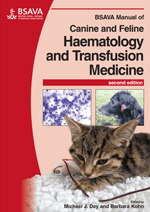
Full text loading...

The haemostatic system is a vital mechanism, the main functions of which are : to guarantee maintenance of vascular integrity, and to maintain blood fluidity under physiological conditions. This chapter considers primary haemostasis; secondary haemostasis (blood coagulation); the cell-based model of blood coagulation; inhibitors of coagulation and fibrinolysis.
Overview of haemostasis, Page 1 of 1
< Previous page | Next page > /docserver/preview/fulltext/10.22233/9781905319732/9781905319732.21-1.gif

Full text loading...






